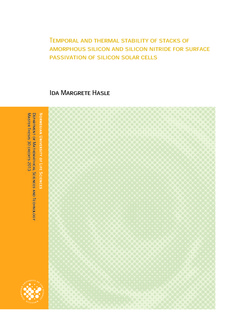| dc.description.abstract | Surface passivation is important for high efficiency solar cells. Stacks of hydrogenated amorphous silicon (a-Si:H) and hydrogenated amorphous silicon nitride (a-SiNx:H) have been shown to provide
good surface passivation. One advantage of this passivation is the low temperature deposition, which means it is energy and cost effective and does not affect the bulk lifetime of the wafer. In previous studies the stacks have been found to provide better passivation than single layers of a-Si:H
or a-SiNx:H. Layers of a-Si:H capped with a-SiNx:H are more stable than single layers of a-Si:H, both with respect to time and temperature.
In this study 10 n-type and 15 p-type wafers were deposited symmetrically on both sides with single layers of a-Si:H, a-SiNx:H or stacks of these two materials, with varying film thicknesses, by plasma enhanced chemical vapour deposition (PECVD). Effective lifetimes were measured using the quasi steady state photoconductance (QSSPC) method and photoluminescence (PL) imaging. The stacks investigated were found to provide very good surface passivation as deposited. The best effective lifetime measured on the n-type samples one day after deposition was 12.5 ms for an excess carrier concentration of 1015 cm-3. The upper limit of the surface recombination velocity (SRV) was calculated to be 1.0 cm/s for this sample. The highest effective lifetime of a passivated p-type wafer was measured to be 5.3 ms for an excess carrier concentration of 1015 cm-3 shortly after deposition of a single layer of 20 nm a-Si:H. The corresponding upper limit of the SRV was calculated to be 2.7 cm/s.
The passivation of the thin a-Si:H single layers were found to degrade rapidly with time. After nine weeks, the effective lifetimes of the p-type samples with 5, 10 and 20 nm a-Si:H films, were reduced to about 30 % of their value one day after deposition. The effective lifetimes of the n-type samples with 5 and 10 nm a-Si:H layers, had decreased to 25 % of their value one day after deposition. The capped a-Si:H layers showed greater temporal stability being relatively stable during the nine weeks
after deposition when measurements were carried out. After nine weeks the best measured lifetime was 11.3 ms corresponding to upper limits of the SRV of 1.3 cm/s on n-type and 4.0 ms
corresponding to an upper limit of the SRV of 3.6 cm/s on p-type. The thickest a-Si:H layer of 40 nm was almost as stable as the stacks. The stacks are probably more stable than the single layers because the silicon nitride prevents the hydrogen from effusing out from the interface with time.
The thermal stability of the passivation is important because of the metallisation processes of solar cells. Rapid thermal annealings (RTA) of the samples were carried out for one minute at different
temperatures. A maximum effective lifetime occurred after annealing at 300-400 C for all the samples, probably because of redistribution of hydrogen, resulting in a lower defect density at the surface and lower SRV. Rapid degradation was observed from 450 C and after annealing at 500 C
the effective lifetimes were below 0.1 ms, probably caused by effusion of hydrogen, resulting in a higher defect density at the surface and higher SRV. A one minute annealing in belt furnace at 450 C
improved the effective lifetime of some samples and degraded others. Some samples improved during the one hour when frequent measurements were made, maybe due to the illumination. A conventional contact firing process at a peak temperature of 945 C degrades the effective lifetime
of all the investigated samples to about the same as an unpassivated sample, thus the stacks and single layers cannot withstand a firing process for metallisation with standard metal pastes. | no_NO |
